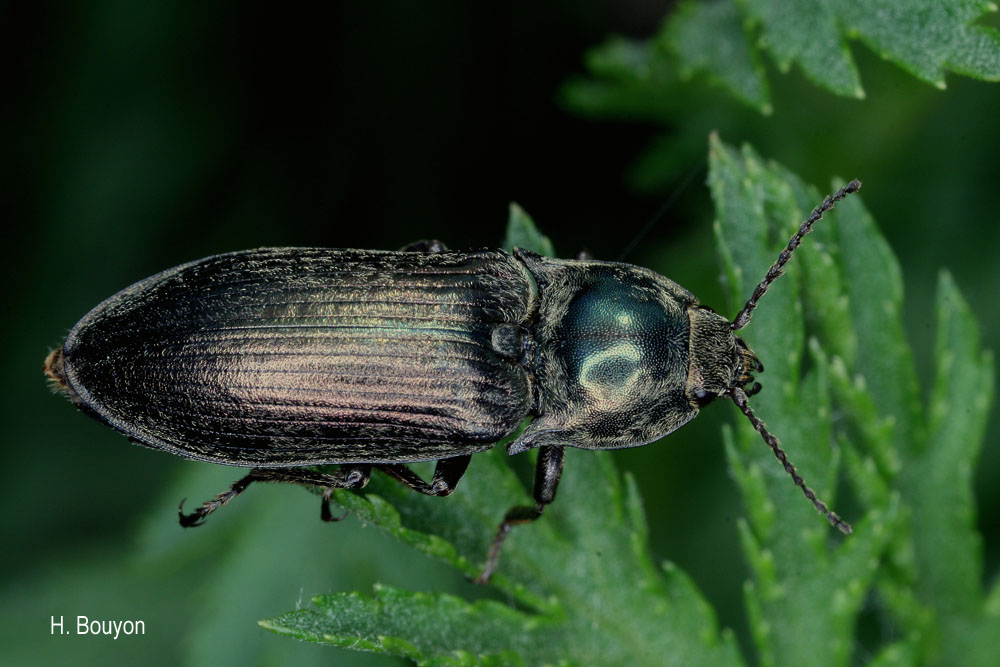
cd_nom

| Author : H.Bouyon |
 |
To get the picture, please visit:
Bouyon Hervé
herve.bouyon@wanadoo.fr
Any reuse of one or more photographs on this site is subject to an authorization request from the author.
Link to the Code of Intellectual Property (Legifrance)

| Author : H. Bouyon (ACOREP-France) / INPN |
 |
To get the picture, please visit:
Any reuse of one or more photographs on this site is subject to an authorization request from the author.
Link to the Code of Intellectual Property (Legifrance)

| Author : A. Artero |
 |
To get the picture, please visit:
Armel Artero
inpn@mnhn.fr
Any reuse of one or more photographs on this site is subject to an authorization request from the author.
Link to the Code of Intellectual Property (Legifrance)
Taille : 11-17 mm
Diagnose :
Corps large, allongé, assez convexe, à pubescent claire bien visible, entièrement cuivreux ou vert métallique peu brillant. Les pattes varient du brun-noir au rougeâtre. Les antennes fortement dentées à partir du 4e article dépassent à peine le milieu du pronotum. Le pronotum est peu convexe, à bords bien arrondis, plus large que long avec les pointes postérieures longues et divergentes. La ponctuation du pronotum est fine et très dense.
Identification : Assez difficile.
Confusions possibles :
Les autres Selatosomus de stature et de coloration proches sont glabres et se rencontrent en altitude.
Périodes d'observation (adultes) : Mai-juin.
Biologie-éthologie :
La larve est terricole et consomme les racines de diverses plantes herbacées. Les adultes se rencontrent sur les fleurs et les plantes basses ou sous les pierres.
Biogéographie-écologie :
Milieux ouverts de plaine de toute l'Europe.
Références :
Leseigneur L., 1972. Coléoptères Elateridae de la faune de France continentale et de Corse. Bulletin mensuel de la Société Linnéenne de Lyon (supplément au numéro de février 1972) 41 : 1-381.
Hervé Bouyon(ACOREP-France),2020
Continental
Metropolitan France
Overseas
Marine
Metropolitan France
Overseas
The map presents a summary at the 10 x 10 km grid of the observation data for the species transmitted to the SINP. These data have been subjected to validation filters.
The map presents a reference distribution layer of the species at the scale of departments and marine sectors. The presence and absence data were established by expertise within a network of partners. This reference distribution is used in the validation process of the SINP data at the INPN level.
Corresponds to a report on the basis of at least one observation proved within a period of 10 years (20 years for little-known invertebrates) preceding the year and no presumption of extinction since obtaining the last data nor doubt on reproductive and implemented nature of this population. For migratory species, the presence indicated concerns areas of reproduction.
This status is based on one or more of the following criteria:
This point covers the absence, more difficult by nature to demonstrate than presence. This status is based on one or more of the following criteria:
This status must be assigned to a department in which the presence of the species is casual.
Particular case of absence due to a proven extinction less than a half century ago (older disappearances are treated as "no probable or definite").
In the state of knowledge, we can not comment on the presence or absence in the current department. This is the default status when not comprised in one of the previous categories or whenever there is doubt.
The map shows the global distribution of the species based on GBIF data (Global Biodiversity Information Facility).
